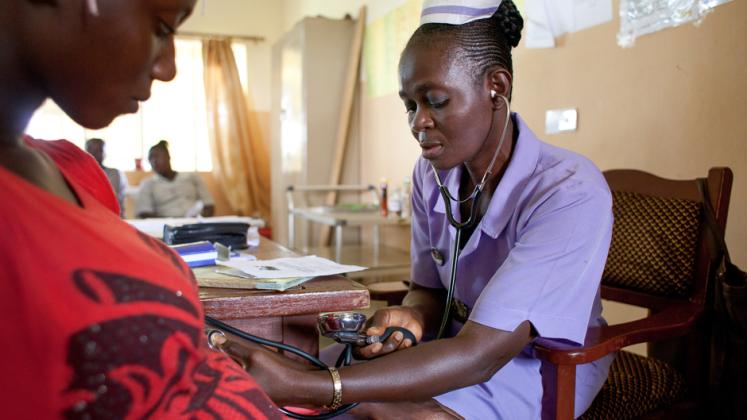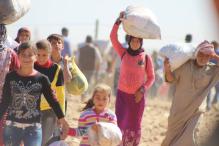The devastating effects of climate change continue to disproportionately affect women and girls in the poorest regions, who have contributed the least to global warming.
Oftentimes, climate change impacts exacerbate socio-economic factors, environmental factors, and the health of women and girls, particularly their sexual and reproductive health and rights (SRHR). Yet, the solutions to address climate change impacts fail to prioritise the needs of SRHR of women and girls in climate action.
Currently, women and girls in the Global South face the double injustice of having limited access to SRHR services and having disproportionately higher exposure to climate change risks.
For example, extreme weather patterns increase the vulnerability to food insecurities, infectious, and vector-borne diseases, combined with disruptions to essential services such as antenatal care due to climate-related infrastructural damages, have had significant implications for maternal and child health outcomes.
In the Asia Pacific region, where water levels are rising, pregnant women have a higher risk of malaria infection due to pregnancy-induced physiological changes. This has also been associated with a higher prevalence of premature delivery, stillbirths, and low-weight births.
Geographical isolation and displacement due to climate change increases the risk of gender-based violence and sexual violence and reinforce poor access to SRHR services. This is evident in South Sudan and Yemen, where the effects of the climate crisis — such as drought and flooding — worsen the humanitarian crisis of famine and conflict.
As such, there have been grave implications on the SRHR of women and girls, including the disruption to family planning, antenatal care, and increasing rates of sexual violence of women and girls.
Furthermore, financial hardships caused by climate shocks also increase the likelihood of school dropouts of girls, resulting in childhood marriages, teenage pregnancies, and sexual trafficking of girls and women. In Uganda, for example, loss of livestock, crop failures, and food insecurities due to extreme droughts, and locust invasion were found to increase school dropouts, reinforce the practice of forced labour among girls, and increase the incidences of child marriages in exchange for food.
During climate emergencies, we have seen the sudden diversions and disinvestments of sexual and reproductive health resources to disaster management, further compromising efficient SRH service and delivery.
This is well documented in the current COVID-19 pandemic, where the burden of the pandemic, combined with the impacts of the climate crisis, particularly on low-resource health systems, has further accentuated the diversion of funds and resources away from routine and essential sexual and reproductive health (SRH) services.
While the demand for SRH services, such as contraceptives, increased during the pandemic, it was found that women and girls faced greater barriers to accessing family planning services, skilled-assisted deliveries, and antenatal care visits.
Additionally, the pandemic halted essential sexual and reproductive health-oriented programs and interventions, which has resulted in increasing rates of female genital mutilation, childhood marriages, and pregnancies.
Despite this evidence, there is little discussion and delayed action in integrating the needs of SRHR in climate adaptation and mitigation plans. This lack of attention will undoubtedly cause major future setbacks in advancing SRHR and reverse some of the hard-won gains in gender equality, particularly for the poorest and most vulnerable women and girls.
The message is clear; we cannot deliver sustainable climate change interventions and adaptations if we do not strengthen the reproductive health and rights of women and girls. Therefore, it is essential at this critical juncture of recovering from the pandemic and addressing the climate crisis, that we look for solutions for collective action. We provide some key suggestions:
Document good practices
In a UNFPA Nationally Determined Contributions report of 50 African countries, only nine countries referenced SRHR in their climate change adaptation strategies. This missing component of how climate change intersects with SRHR and limited discussions on risk management plans are concerning.
A starting point is to take a more proactive approach by documenting good practices of how countries and organisations have previously worked to ensure strengthened access to SRHR services before, during and after disasters.
These can serve as guiding strategies to improve targeted local and national interventions to support women’s SRHR in the context of climate change. Additionally, dialogue between key actors working on climate change response and those working in SRHR provides valuable opportunities to share lessons and exchange hard-won solutions to advance gender equality in health programmes.
In this regard, the Gender and Health Hub at The United Nations University, International Institute of Global Health (UNU-IIGH) is organising a side-event at the CSW66, focusing on applying these transferrable lessons from the SRHR space to climate change responses.
Shifting focus of the climate change responses
Most climate change-related mitigation efforts advocate family planning as a win/win approach due to evidence linking reduced population growth to improved climate change outcomes. This approach is both problematic and simplistic. First, it is problematic as it shifts responsibility from the Global North — the largest contributor to global warming — to women in the Global South and emphasises reproductive control.
Second, it is simplistic as it fails to address how underlying drivers of vulnerability — such as power dynamics, access, intersectionality, and poor health systems — combine to create significant barriers that prevent women’s improved SRH and resilience to climate change.
Thus, there is a need to shift focus from reproductive control to managing the SRHR outcomes of vulnerable women and girls as part of climate change adaptation strategies. This involves strengthening health systems and reducing other SRHR vulnerabilities (e.g., FGM, child marriage) that may be exacerbated due to climate shocks.
Engage women and girls
Women and girls of diverse cultural and ethnic backgrounds and identities need to be recognised as key actors and be given prominent roles in planning climate change adaptation strategies that address social vulnerabilities at all levels.
Equal partnerships and consultations with feminist organisations, advocacy groups, and female-led community groups are also important to raise awareness, promote the acceptability of interventions, and increase reach to vulnerable women (e.g. women with disabilities). This ensures that reproductive health needs are considered and met as part of disaster management plans.
Increase SRHR financing as part of emergency preparedness
There is a need to move beyond a ‘zero sum’ game of diverting resources from SRHR during emergencies to seeing the mutual benefits that can occur when SRH services are strengthened during climate shocks.
This involves increasing public spending on the scale-up of SRH programmes, improving affordability, and building the capacity of reproductive health systems to effectively sustain SRH services and deliver timely responses during climate shocks.
Women and girls face heightened vulnerabilities to both climate shocks and access to SRH services. The adverse effects of climate change are already exacerbating an already stark problem of unmet need with regards to SRHR.
Recognising that women’s rights are human rights, a shared agenda between strengthening women’s reproductive health and building climate change resilience is needed to achieve a sustainable tomorrow and ensure that no one gets left behind.
•••
This article is republished with the permission of Inter Press Service News. Read the original article on the Inter Press Service News website.
Suggested citation: Gabriela Fernando, Oluseye Ayomide. "Collective Solutions to Improve Sexual and Reproductive Health Rights in Climate Action," United Nations University, UNU Centre, UNU-IIGH, 2022-03-08, https://unu.edu/article/collective-solutions-improve-sexual-and-reproductive-health-rights-climate-action.





